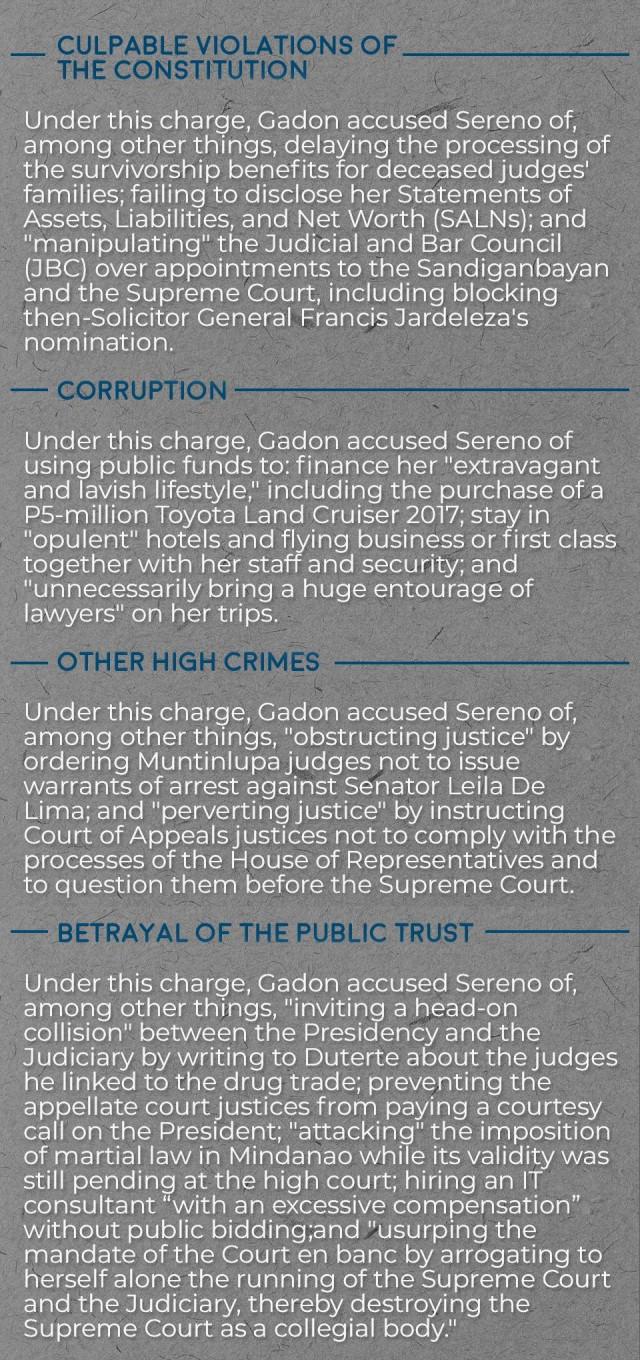The impeachment complaint and quo warranto petition vs. Sereno
Maria Lourdes Aranal Sereno was named the 24th Chief Justice of the Supreme Court on August 24, 2012, two years and eight days after she was sworn into the high tribunal as associate justice by President Benigno Aquino III.
Sereno succeeded Renato Corona, who became the first Chief Justice of the Philippines to be impeached. On May 29, 2012, he was convicted by the Senate impeachment court of betrayal of public trust and culpable violation of the Constitution for not fully disclosing his assets in his statements of assets, liabilities and net worth (SALNs).
Sereno, 52, became the first woman and the second youngest person to serve as Chief Justice of the nation's highest court.
Impeachment complaint
The idea of Sereno being impeached was floated during the Aquino administration, for instance by Ilocos Norte Representative Rodolfo Fariñas, who in 2014 said he was mulling filing an impeachment complaint against her over the Judiciary Development Fund (JDF).
But the move to impeach Sereno truly gained momentum during the Duterte administration, when the Chief Justice found herself at odds with the new President not long after his inauguration.
The two officials butted heads over President Rodrigo Duterte's "narco-lists"; the rising death toll in his war on drugs; his intention allow Ferdinand Marcos' burial in the Libingan ng mga Bayani; his disparagement of human rights; and both his imposition of martial law in Mindanao and its extension.
While lawyer Lorenzo Gadon has insisted that Duterte has no involvement in his impeachment complaint against the Chief Justice, the President has launched tirades against Sereno, dared her to resign, and threatened to file an impeachment complaint against her himself. Duterte's allies also form the "supermajority" in the House of Representatives.

On September 13, 2017, the House justice committee found Gadon's impeachment complaint against Sereno "sufficient in form and substance." Three weeks later, on October 5, it also found sufficient grounds for the complaint.
Gadon accused the Chief Justice of committing culpable violation of the Constitution; corruption; other high crimes; and betrayal of public trust.
The House justice committee began its hearings on the impeachment complaint on September 13. Over the next five months, the panel met 18 times, wrapping up on February 27. During this period, several Supreme Court justices attended the hearing to testify against Sereno, who did not appear.
Sereno held firm throughout against calls for her resignation, but on March 1 was "forced" to go on "indefinite leave" when 13 other Supreme Court justices said that if she did not do so, they would publicly call for her resignation. (Sereno would stay away until May 9, when she resumed her duties.)
On March 8, the House Committee on Justice by a vote of 38-2 found probable cause to continue with Sereno's impeachment at the Senate.
On March 19, House justice committee members approved 33-1 the committee report and articles of impeachment, which were transmitted to the House rules committee to be scheduled for voting in the plenary.
Quo warranto
However, in March came a development that resulted in Sereno calling for her own impeachment trial. Solicitor General Jose Calida filed a petition for quo warranto against her before the Supreme Court, questioning the validity of her appointment.
According to the rules of court, the government can initiate quo warranto proceedings against a person who “usurps, intrudes into, or unlawfully holds or exercises a public office”—which Calida accused Sereno of doing due to her allegedly incomplete submission of SALNs.
Calida had been prompted to do so by a letter sent by lawyer Eligio Mallari, whose own impeachment complaint against the Chief Justice had been junked by the House panel. Mallari would later ask to stand witness against Sereno on a separate allegation that she delayed the resolution of cases involving his ownership of two parcels of land.
The quo warranto option has been condemned by lawmakers, law professors, and civic groups, who have called it unconstitutional and stressed that the only way to remove an impeachable officer should be through impeachment.
Senate President Aquilino Pimentel III said that a quo warranto solution would circumvent the Senate’s mandate to act as impeachment court, while former Chief Justice Hilario Davide Jr. said that any quo warranto petition should have been filed within a year of Sereno’s accession to the position.
Nevertheless, the Supreme Court on Friday, May 11, voted on Calida’s quo warranto petition. With a vote of eight for and six against, the Supreme Court justices voted to remove Sereno from the post of Chief Justice.
Those who voted against this recourse were Acting Chief Justice Antonio Carpio and Associate Justices Marvic Leonen, Benjamin Caguioa, Estela Perlas Bernabe, Presbitero Velasco Jr., and Mariano Del Castillo.
Will impeachment complaint continue?
Pimentel has said that even if the Supreme Court votes to proceed with the quo warranto, it is still up to the House whether or not to proceed with the impeachment complaint.
The lower chamber is set to resume session on May 15. A vote on the committee report and the articles of impeachment had been awaiting the plenary.
An impeachment complaint only needs the support of one-third of all House members for it to be transmitted to the Senate for trial.
If the impeachment complaint reaches the Senate, the 23 senators will act as the impeachment court. A conviction would need the vote of at least two-thirds of them—16 senators. —Barbara Marchadesch/KG, GMA News



